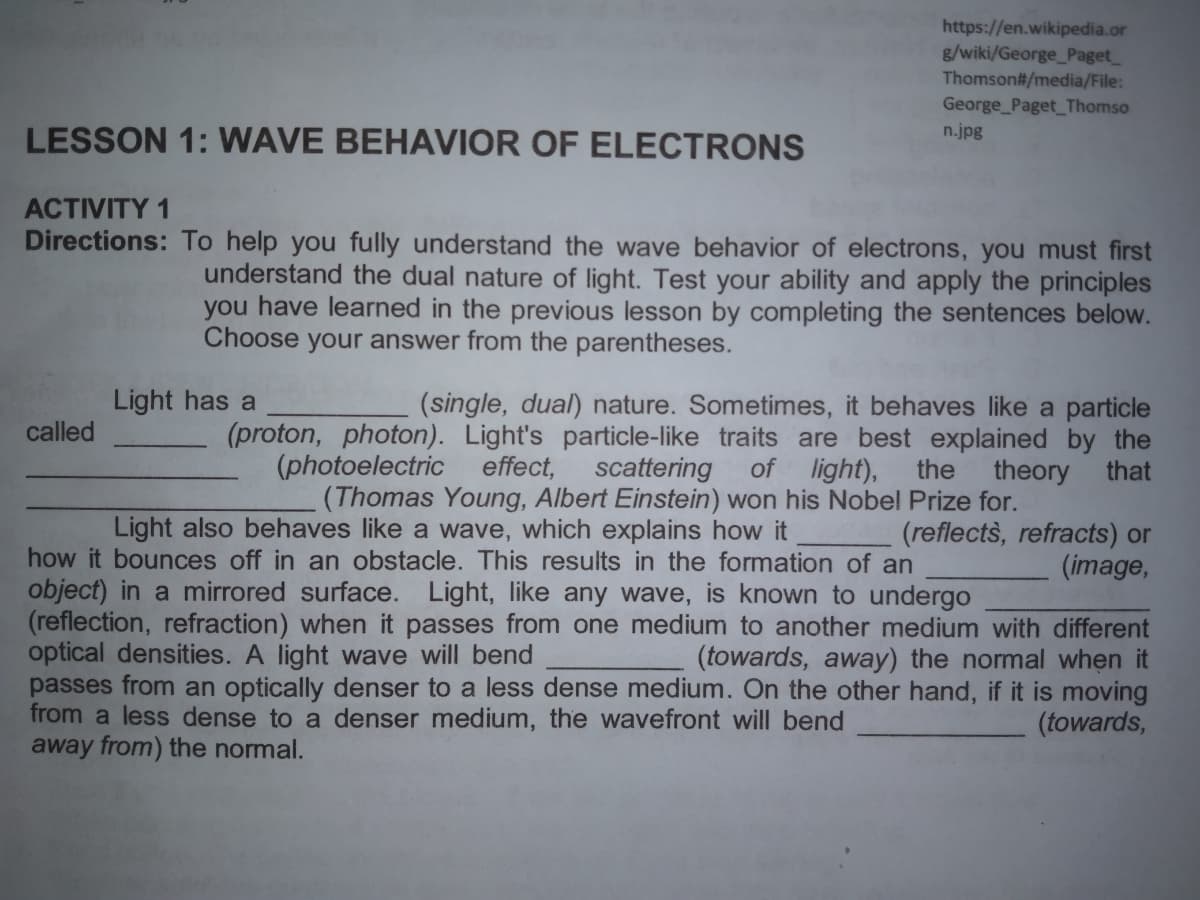Light has a (single, dual) nature. Sometimes, it behaves like a particle called (proton, photon). Light's particle-like traits are best explained by the scattering (Thomas Young, Albert Einstein) won his Nobel Prize for. (photoelectric effect, of light), the theory that Light also behaves like a wave, which explains how it (reflects, refracts) or (image, how it bounces off in an obstacle. This results in the formation of an object) in a mirrored surface. Light, like any wave, is known to undergo (reflection, refraction) when it passes from one medium to another medium with different optical densities. A light wave will bend passes from an optically denser to a less dense medium. On the other hand, if it is moving from a less dense to a denser medium, the wavefront will bend away from) the normal. (towards, away) the normal when it (towards,
Light has a (single, dual) nature. Sometimes, it behaves like a particle called (proton, photon). Light's particle-like traits are best explained by the scattering (Thomas Young, Albert Einstein) won his Nobel Prize for. (photoelectric effect, of light), the theory that Light also behaves like a wave, which explains how it (reflects, refracts) or (image, how it bounces off in an obstacle. This results in the formation of an object) in a mirrored surface. Light, like any wave, is known to undergo (reflection, refraction) when it passes from one medium to another medium with different optical densities. A light wave will bend passes from an optically denser to a less dense medium. On the other hand, if it is moving from a less dense to a denser medium, the wavefront will bend away from) the normal. (towards, away) the normal when it (towards,
College Physics
1st Edition
ISBN:9781938168000
Author:Paul Peter Urone, Roger Hinrichs
Publisher:Paul Peter Urone, Roger Hinrichs
Chapter30: Atomic Physics
Section: Chapter Questions
Problem 1PE: Using the given charge-to-mass ratios for electrons and protons, and knowing the magnitudes of their...
Related questions
Question

Transcribed Image Text:https://en.wikipedia.or
g/wiki/George_Paget
Thomson#/media/File:
George Paget_Thomso
n.jpg
LESSON 1: WAVE BEHAVIOR OF ELECTRONS
ACTIVITY 1
Directions: To help you fully understand the wave behavior of electrons, you must first
understand the dual nature of light. Test your ability and apply the principles
you have learned in the previous lesson by completing the sentences below.
Choose your answer from the parentheses.
Light has a
(single, dual) nature. Sometimes, it behaves like a particle
(proton, photon). Light's particle-like traits are best explained by the
theory
(Thomas Young, Albert Einstein) won his Nobel Prize for.
called
(photoelectric effect, scattering
of light),
the
that
Light also behaves like a wave, which explains how it
(reflects, refracts) or
(image,
how it bounces off in an obstacle. This results in the formation of an
object) in a mirrored surface. Light, like any wave, is known to undergo
(reflection, refraction) when it passes from one medium to another medium with different
optical densities. A light wave will bend
passes from an optically denser to a less dense medium. On the other hand, if it is moving
from a less dense to a denser medium, the wavefront will bend
away from) the normal.
(towards, away) the normal when it
(towards,
Expert Solution
This question has been solved!
Explore an expertly crafted, step-by-step solution for a thorough understanding of key concepts.
This is a popular solution!
Trending now
This is a popular solution!
Step by step
Solved in 2 steps

Knowledge Booster
Learn more about
Need a deep-dive on the concept behind this application? Look no further. Learn more about this topic, physics and related others by exploring similar questions and additional content below.Recommended textbooks for you

College Physics
Physics
ISBN:
9781938168000
Author:
Paul Peter Urone, Roger Hinrichs
Publisher:
OpenStax College

Glencoe Physics: Principles and Problems, Student…
Physics
ISBN:
9780078807213
Author:
Paul W. Zitzewitz
Publisher:
Glencoe/McGraw-Hill

Stars and Galaxies (MindTap Course List)
Physics
ISBN:
9781337399944
Author:
Michael A. Seeds
Publisher:
Cengage Learning

College Physics
Physics
ISBN:
9781938168000
Author:
Paul Peter Urone, Roger Hinrichs
Publisher:
OpenStax College

Glencoe Physics: Principles and Problems, Student…
Physics
ISBN:
9780078807213
Author:
Paul W. Zitzewitz
Publisher:
Glencoe/McGraw-Hill

Stars and Galaxies (MindTap Course List)
Physics
ISBN:
9781337399944
Author:
Michael A. Seeds
Publisher:
Cengage Learning


Foundations of Astronomy (MindTap Course List)
Physics
ISBN:
9781337399920
Author:
Michael A. Seeds, Dana Backman
Publisher:
Cengage Learning